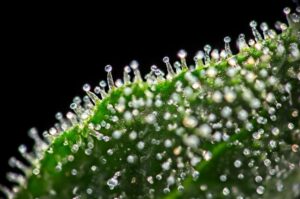Trichome

Trichomes are what give cannabis its distinctive smell and taste. They also play a role in the plant’s self-defense, as they produce a sticky resin that deters predators.
Non-glandular trichomes, also called cystoliths, are responsible for the plant’s physical defense as they impale insects that try to feed on the plant. Glandular trichomes, on the other hand, produce cannabinoids and terpenes. They are categorized into Bulbous, Capitate-sessile, and Capitate-stalked trichomes, each with different functions.
Trichomes usually appear during the cannabis plant’s flowering stage. Their appearance starts as completely clear, then opaque, milky white, and finally amber or brown when the plant is ready for harvest.
Growers pay attention to trichomes to determine when the plants have peaked in maturity. Cannabis plants with high trichome levels are more potent and produce higher yields.

Get Your Free eBook!
Download our FREE resource, The Ultimate Edibles Guidebook, full of recipes, infusion tips and everything you need to make your first batch of edibles today!
